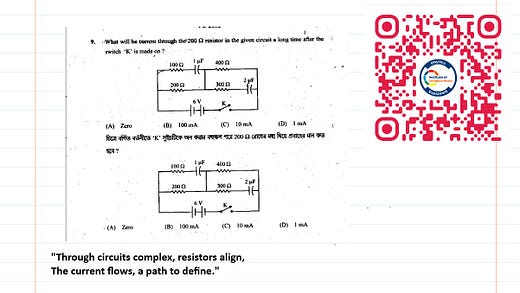Mastering DC Circuits: Solving Resistor-Capacitor Networks in Steady State"
Physics Explained for NEET, WBJEE, VITEE, BITSAT, JEE mains, APEAMCET-Sample Video Included
To solve direct current (DC) circuits that include resistors and capacitors, where the capacitor has been connected for a long time, follow these steps:
Key Concept: Capacitor Behavior in a DC Circuit
Steady State: After a long time (in the context of a DC circuit), the capacitor is fully charged, and no current flows through it. The capacitor behaves like an open circuit (infinite resistance) in steady state.
Steps to Solve the Circuit
Redraw the Circuit for Steady State:
Replace the capacitor with an open circuit.
This eliminates any current through the branch containing the capacitor.
Simplify the Circuit:
Analyze the resulting circuit, which now consists only of resistors and possibly voltage sources.
Use series and parallel resistor combinations to simplify the circuit.
Apply Kirchhoff’s Laws (if necessary):
Kirchhoff's Current Law (KCL): The total current entering a junction equals the total current leaving it.
Kirchhoff's Voltage Law (KVL): The sum of potential differences in a closed loop is zero.
Calculate Circuit Parameters:
Determine currents and voltages across the resistors using Ohm’s Law: V=IR
Determine the Capacitor Voltage:
The voltage across the capacitor in steady state is equal to the voltage across the branch where it is connected.
Example Problem
Circuit: A DC source of VVV volts is connected to a resistor R1, and a capacitor C is in parallel with another resistor R2
Solution:
Steady-State Behavior:
The capacitor is fully charged and behaves like an open circuit.
No current flows through the branch with the capacitor.
Simplify the Circuit:
Ignore the branch containing the capacitor.
The circuit is now a simple series or parallel resistor combination (depending on the configuration).
Analyze the Resistors:
If R1 and R2 are in series, calculate the equivalent resistance: Req=R1+R2
If R1 and R2 are in parallel: Req=(R1R2)/ (R1+R2)
Find Current and Voltage:
Total current from the source: I=V Req
Voltage across each resistor can be calculated using V=IR.
Voltage Across the Capacitor:
In steady state, the voltage across the capacitor equals the voltage across R2(if in parallel).
Key Tips
In steady state, always treat the capacitor as an open circuit for DC analysis.
Use equivalent resistance calculations to simplify complex resistor networks.
Double-check connections (series or parallel) before simplifying the circuit.






